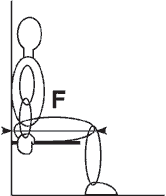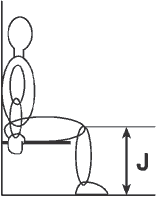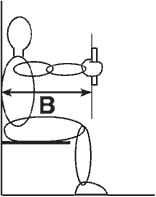 |
Hi, Andy here. Just a short note to say the Hinault/Genzling sizing method worked for me and may work for you.
Go ahead and give it a try. My riding position feels right - now for some riding form! |
Custom Frame Sizing If you are a competitive cyclist looking to maximize your power output
or are simply looking to achieve an optimum riding position on your bike, a Strawberry "made to measure" frameset may be for you.
Building a frame to measure has been accomplished over the years in several ways including Italian sizing charts,
size-cycles, countryside jaunts with the local framebuilder, etc. Given that I am a "Torch Bearer" rather than an ergonometrician, I will
present a sizing procedure developed in the 1980's in a study of professional cyclists undertaken by Frenchman Claude Genzling. Genzling
interviewed hundreds of pro road cyclists gaining body measurements and respective cycle frame dimensions. This data was combined with
photographic studies of the rider's position on the bike. Working in close collaboration with five time Tour de France winner Bernard Hinault,
Genzling experimentally developed basic relationships between pro racing cyclists morphology and riding position and bicycle frame design. In
the mid 1980's, I converted Genzling's graphical frame sizing technique into an analytical sequence which is presented here in a computerized
format for your enjoyment. So, get a buddy to help you take the body dimensions and then enter the numbers into the program and have some fun
designing your frame.
OBTAINING BODY MEASUREMENTS
You will need a carpenters square, a stool and wall, tape measure, wooden dowel. Once your tool kit is assembled,
proceed to measuring the six dimensions:
|
A) INSEAM "E": Place square between legs with the long edge against wall, raise as much as possible, then measure from
top edge of square to floor (cyclist without shoes).
| 
|
|
B) THIGH "F": Sitting erect on stool press pelvis against wall and hold lower legs vertically - place square against
kneecaps and measure from wall to square.
| 
|
|
C) LOWER LEG "J": Sitting erect on stool place long edge of square across
knees just behind kneecaps - measure from floor to square.
| 
|
|
D) TRUNK "T": Sitting erect on stool press pelvis against wall - rest square horizontally on bulge of collarbone - measure
from stool to square.
| 
|
|
E) ARM "B": In same position as for trunk measurement, grip dowel vertically - raise arm to horizontal and perpendicular
to wall - measure from wall to close edge of dowel.
| 
|
|
F) FOREARM "A": Hold dowel perpendicularly to forearm - rest elbow on table with forearm perpendicular to table - measure
from table to close edge of dowel.
| 
|
DESIGNING YOUR FRAME
Using your inseam measurement "E", go to Table no. 1 to select the initial values of saddle setback "R", saddle to handlebar dimension
"S", and the vertical distance from the saddle to the stem D.
TABLE NO. 1
E
Inseam |
R
Saddle
setback |
S
Saddle to bar |
D
Saddle to stem |
| 75 to 78cm. |
4 to 6cm. |
47 to 51cm. |
5 to 6cm. |
| 79 to 82cm. |
5 to 7cm. |
50 to 54cm. |
6 to 7cm. |
| 83 to 86cm. |
6 to 8cm. |
53 to 57cm. |
7 to 8cm. |
| 87 to 90cm. |
7 to 9cm. |
56 to 60cm. |
8 to 9cm. |

NOMENCLATURE
H SEAT TUBE CENTERLINE LENGTH
L TOP TUBE CENTERLINE LENGTH
h CRANK HANGER CENTERLINE DISTANCE ABOVE GROUND
t HEAD TUBE ANGLE
I SEAT TUBE SETBACK
Av FRONT WHEELBASE
Ar REAR WHEELBASE
M DIAMETER OF HANDLEBAR
f FORK OFFSET
G STEM LENGTH (CENTERLINE OF HANDLEBAR TO CENTERLINE OF BOLT)
c TRAIL (CASTOR)
Q SEAT TUBE ANGLE
Hs SADDLE HEIGHT (CENTERLINE FROM CRANK HANGER TO SADDLE TOP)
R SADDLE SETBACK FROM PLUMB LINE THROUGH CRANK HANGER
N SADDLE LENGTH
S SADDLE NOSE TO HANDLEBAR NEAR EDGE
D HEIGHT DIFFERENCE BETWEEN SADDLE & BAR TOPS
E INSEAM
F THIGH (FEMUR)
J LOWER LEG (TIBIA)
T TRUNK
B ARM
A FOREARM
Next, measure the length of your saddle "N". Now select a head angle "t" in the range of say 72 to 74 degrees
(you may wish to consult with your framebuilder!). Then select a stem length "G" noting that a rough guide is as follows: for
top tube lengths "L" between 45 to 48cm. choose a stem in the range of 8 to 11cm.; for "L" between 50 and 52cm. choose "G" equal to
10 to 12cm.; for "L" between 54 and 56cm. choose a stem between 11 and 13cm. and for a 58 to 60cm. top tube choose a stem between
12 and 14cm. Lastly, determine the handlebar clamp diameter "M" that you will be using (generally either 2.58cm. or 3.18cm. for
the oversized handlebars).
MORPHOLOGIC RATIOS
Once the measurements are to hand, calculate the following ratios which will help refine your final frame design.
FINAL CALCULATIONS
Now enter these values into the design format and the scheme will give "Hs", the saddle height from the center
of the bottom bracket; "H", the seat tube centerline length; "l", the seat tube setback; "Q", the seat tube angle to the top tube and "L",
the top tube centerline length.
| Results will display here when the required fields have all been filled out. |
|
